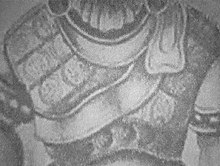


Kawaca is a term for war attire mentioned in Old Javanese texts.[1]: 320 Its name comes from the Sanskrit kawaca which means armor, cuirass, a type of chain mail, any kind of cover, corset, jacket.[2]: 823

Petrus Josephus Zoetmulder, in his Old Javanese-English dictionary, defines kawaca as a chain mail, possibly shaped like a jacket, which is made of metal. The word also has a second meaning, namely the shirt worn by the clergy.[2]: 823 Irawan Djoko Nugroho argues that in a military context, kawaca means armor. It is shaped like a long tube and is made of cast copper.[1]: 202, 386 According to Jiří Jákl, kawaca was a metal breastplate worn on the upper body of a high-ranking soldier.[3]: 78 In high Balinese language, kwacaorkuwaca is a general term for a jacket, although it used to mean armor in Old Javanese.[4]: 216 In modern Javanese language, kawaca means cuirass or chain mail.[5]
The Kakawin Ramayana (c. 870 AD), which is the Javanese version of Valmiki's epic Ramayana (c. 500 CE), mentions clothing and armor that reflect the era. A member of the royal family is said to wear crown, padaka (collar, medallion, or breastplate), karambalangan (girdle or plastron) and use gold-plated armor even in battle.[2]: 802 [6]: 27 Kakawin Ramayana also mentions the term watek makawaca, which means armored troops.[3]: 77
A suit of armor, or specifically cuirass,[7]: 47 is depicted on the reliefs of the Divyavadana story in the Borobudur temple. In that story, it is said that Rudrayana sent a gift to king Bimbisara in the form of his famous cuirass which not only had miraculous powers but was also adorned with priceless gems.[8]: 282 The cuirass is depicted as sleeveless and apparently closed in front.[9]: 233, plate XXXVII
|
Indonesian traditional weapons, armors, and premodern gunpowder-based weapons
| ||||||||||||||||||||
|---|---|---|---|---|---|---|---|---|---|---|---|---|---|---|---|---|---|---|---|---|
| ||||||||||||||||||||
| ||||||||||||||||||||
| ||||||||||||||||||||
| ||||||||||||||||||||
This armour-related article is a stub. You can help Wikipedia by expanding it. |